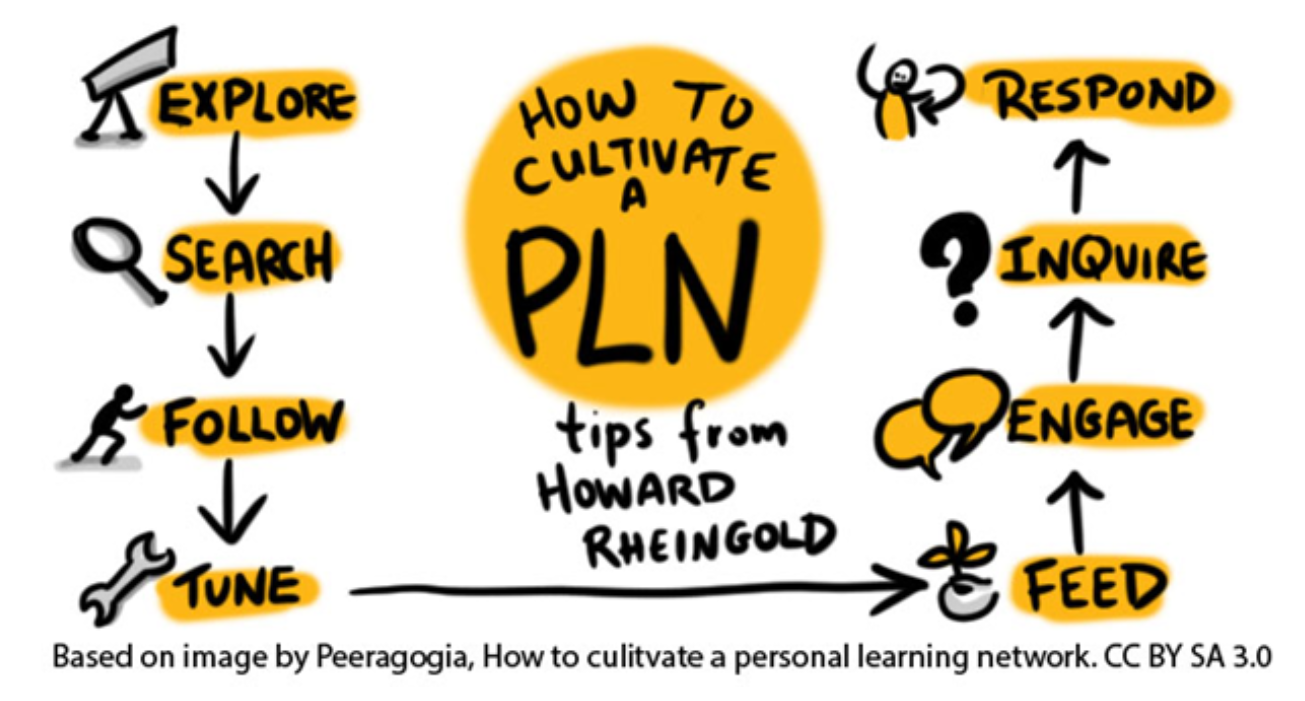The next Ontario Extend activity (in the Collaborator module) is to determine how to cultivate my personal learning network (PLN). This is timely for me because I have spent the last year seeking opportunities for growth and to expand upon what I would refer to as my personal learning circle. I think in the past year I have been in the explore, search, and follow phases as depicted in the image below.

Howard Rheingold’s (2014) reading is focused on cultivating an online PLN and while these are important Alan Levine (personal communication, 2019) tells us we can think of cultivating a PLN in other ways that may extend outside of social media networks.
Last year, I was involved in co-leading a symposium for teachers who teach in similar programs and similar courses that I do. Through this symposium I realized that we were facing the same rapid changes in our industry, we had similar changes in our student population, similar challenges to delivery, student engagement, and emerging technologies. It seemed to me that we were all working on the same issues but within the silos of our own organizations and that staying connected and sharing resources could be beneficial.
In retrospect, I wish we would have added a formal social networking element to the event. For example, a Twitter hashtag, Facebook page or Instagram account. I realize now, this may have been a simple way to stay connected while exposing many participants to the plethora of learning networks available through twitter and other social media mediums. However, I know personal learning networks were formed and connections were made and I still reach out to the connections I made albeit, usually through email. I wonder is email the new snail mail?
At my institution I have searched out opportunities to expand my PLN through in-house PD opportunities, participating in initiatives through the Teaching and Learning Centre, sharing information about eCampus Ontario and my participation in this mOOC. I am mindful to inquire about PD opportunities that my fellow faculty members have attended and compare what I am learning to what they are sharing.
The social media educators and associations that I follow via Twitter and LinkedIn are faculty from my organization, Cult of Pedagogy, MicrosoftEduCa, OISEUofT, and TED-ED. Primarily, I have explored, searched, and followed these sites inconsistently. It was through my Twitter account that I found out about the eCampus Ontario courses and this mOOC.
Since starting this mOOC I have become active on Twitter which includes commenting and re-sharing tweets. This was intimidating at first because once the tweet has been sent, the thought no longer belongs to me. I wish that Twitter had an edit feature as the only way to make a correction is to delete the tweet and any comments that have been made along with it.
In the Collaborator Module, I am expanding my PLN by following: commenting and retweeting my fellow extenders and eCampus Ontario fellows. I took suggestions to follow Dr. George Couros, Dr. Veletsianos, and Educause. I have expanded my educational social media followings through LinkedIN, Instagram, and Facebook. Previously, I had compartmentalized those accounts into either personal or business.
Rheingold (2014) recommends following people who interest you and he refers to this as tuning your network. I noticed that one organization I was following was quite negative so I stopped following them. Davison, Hagel III, & Brown (2010) argue that is important to stretch out of your own thinking and seek out other interests and differing points of view to follow. I agree that it is important to seek out discourse but I think it must remain professional. In my opinion this is important to my online presence.
An interesting notion I have learned is regarding filter bubbles. Pariser (2011) suggests it is important to watch for filter bubbles meaning ways the internet filters your options based on what you have previously viewed. I noticed a few years ago, after vacationing in Quebec, that I was receiving advertisements and news from Quebec City in my social media accounts. So, it is interesting to think about how filter bubbles excludes information that may challenge my thinking or at least expose me to other perspectives. To learn more about filter bubbles from Eli Pariser watch the Ted Talk below.
References:
Davison, L., Hagel III, J., & Brown, J. S. (2010). Deloitte Development LLC. eCampus Ontario. (2019). EXTEND 101-EN.1 – Extend MOOC. Module 4: Collaborator, FlipGrid Extend Activity, Alan Levine (personal communication)
eCampus Ontario. (2019). EXTEND 101-EN.1 – Extend MOOC. Module 4: Collaborator, Ways to Collaborate
Rheingold, Howard. Net Smart: How to Thrive Online. Cambridge, Massachusetts: The MIT Press, 2012. Print.